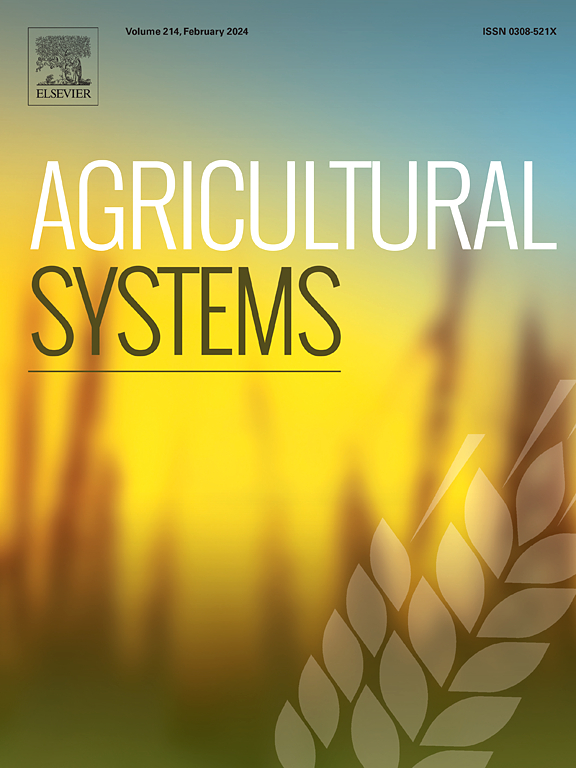Forecasting the performance of alternative sheep production systems grazing perennial pastures
IF 6.1
1区 农林科学
Q1 AGRICULTURE, MULTIDISCIPLINARY
引用次数: 0
Abstract
Context
Grazing enterprises employ a range of management strategies in rain-fed Australian sheep production systems, which alters both production potential and profitability. This research used a stochastic whole-farm simulation modelling methodology to assess the impact of six different management regimes on the long-term profitability of a model farm simulated from August 1971 to July 2018.
Objective
We aimed to 1) compare the whole farm productivity and economics of the different sheep production systems, 2) identify the factors that were driving the differences between systems, and 3) determine if the profitability and ranking of systems changed in response to different market and environmental conditions.
Method
Stochastic simulation whole-farm modelling, combined AusFarm® biophysical simulation data, with forecasted @Risk modelling price time series data. The economic and financial performance of different sheep management systems were assessed using gross margins, cash flows, net present values (NPV), coefficient of variation (CoV) and cash flow modified internal rates of return (MIRR).
Results and conclusions
Decisions on the management of sheep system mating times, breed of ram, type of pasture grazed and retention of ewe lambs affected supplementary feeding costs as well as production of wool and meat. Production differences along with variation in prices received explained why the six sheep systems had significantly different economic gross margins and NPVs. The systems also had different risks in achieving economic returns. Higher economic returns were associated with higher risks of variable returns and lower returns with lower risk of variation. The earlier mated (February) and terminal systems did not perform economically as well as the later mated (April) systems, but were more reliable with lower risk. The winter lambing Merino system had the lowest gross margins and NPV, but also the lowest risk CoV and MIRR. Investment in additional lucerne pasture for early summer feed paid off with greater gross margins and NPV, but with highest risk CoV and MIRR that these economic returns may vary.
Significance
Modelling incorporating historical long-term price and production risk clarified the complex effects of sheep system management decisions on production and economic returns. The more basic gross margin analysis gave the same ranking of the different sheep production systems as the more complex NPV and MIRR. Potential economic effects and risks of variable returns can be understood by examining past variability in production and prices received (revenues) on gross margins then assessing expected risk of future variability.

预测多年生牧场替代绵羊生产系统的生产性能
放牧企业在雨养澳大利亚羊生产系统中采用了一系列管理策略,这改变了生产潜力和盈利能力。本研究使用随机全农场模拟建模方法,评估了1971年8月至2018年7月模拟的六种不同管理制度对模型农场长期盈利能力的影响。我们的目的是1)比较不同绵羊生产系统的整个农场生产力和经济性,2)确定驱动系统之间差异的因素,以及3)确定系统的盈利能力和排名是否会随着不同的市场和环境条件而变化。方法随机模拟全农场模型,结合AusFarm®生物物理模拟数据,预测@Risk模型价格时间序列数据。采用毛利率、现金流量、净现值(NPV)、变异系数(CoV)和现金流量修正的内部收益率(MIRR)对不同绵羊管理系统的经济和财务绩效进行了评估。结果与结论羊系配种次数、公羊品种、放牧草场类型和母羊保留的管理决策影响补饲成本以及毛肉产量。产量的差异以及价格的变化解释了为什么六种绵羊系统的经济毛利率和净现值有显著差异。这些制度在实现经济回报方面也有不同的风险。较高的经济回报与较高的可变回报风险相关,而较低的回报与较低的变异风险相关。较早交配(2月)和终端系统的经济性能不如较晚交配(4月)系统,但更可靠,风险更低。冬羔美利奴体系毛利率和净现值最低,但CoV和MIRR风险也最低。投资额外的卢森牧草用于初夏饲料获得了更高的毛利率和净现值,但CoV和MIRR风险最高,这些经济回报可能会有所不同。纳入历史长期价格和生产风险的模型阐明了牧羊系统管理决策对生产和经济回报的复杂影响。更基本的毛利率分析给出了与更复杂的NPV和MIRR相同的不同绵羊生产系统的排名。潜在的经济影响和可变回报的风险可以通过检查过去毛利率的生产和价格(收入)的可变性,然后评估未来可变性的预期风险来理解。
本文章由计算机程序翻译,如有差异,请以英文原文为准。
求助全文
约1分钟内获得全文
求助全文
来源期刊

Agricultural Systems
农林科学-农业综合
CiteScore
13.30
自引率
7.60%
发文量
174
审稿时长
30 days
期刊介绍:
Agricultural Systems is an international journal that deals with interactions - among the components of agricultural systems, among hierarchical levels of agricultural systems, between agricultural and other land use systems, and between agricultural systems and their natural, social and economic environments.
The scope includes the development and application of systems analysis methodologies in the following areas:
Systems approaches in the sustainable intensification of agriculture; pathways for sustainable intensification; crop-livestock integration; farm-level resource allocation; quantification of benefits and trade-offs at farm to landscape levels; integrative, participatory and dynamic modelling approaches for qualitative and quantitative assessments of agricultural systems and decision making;
The interactions between agricultural and non-agricultural landscapes; the multiple services of agricultural systems; food security and the environment;
Global change and adaptation science; transformational adaptations as driven by changes in climate, policy, values and attitudes influencing the design of farming systems;
Development and application of farming systems design tools and methods for impact, scenario and case study analysis; managing the complexities of dynamic agricultural systems; innovation systems and multi stakeholder arrangements that support or promote change and (or) inform policy decisions.
 求助内容:
求助内容: 应助结果提醒方式:
应助结果提醒方式:


